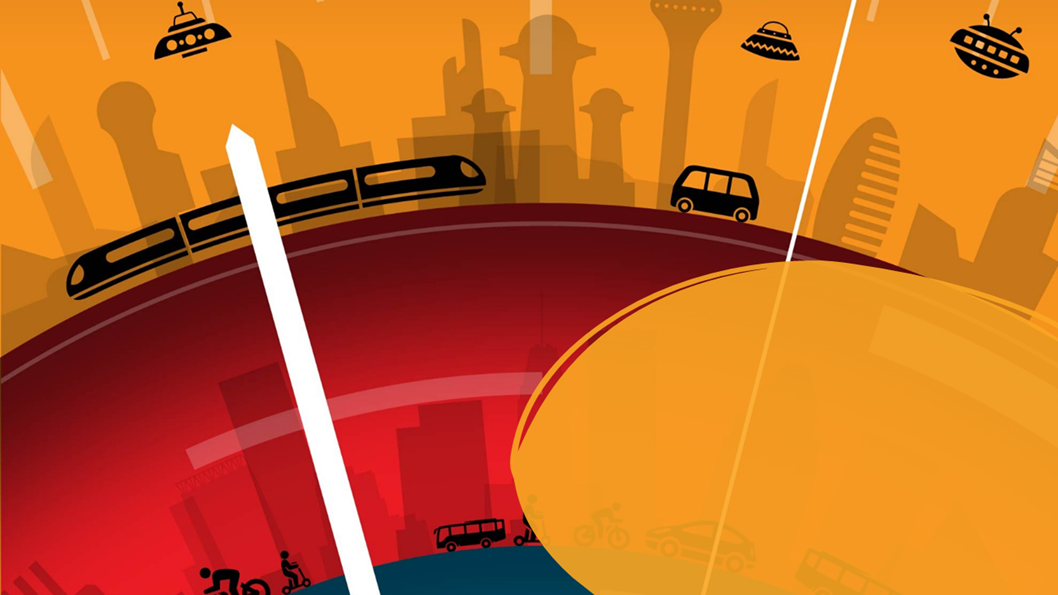A brand new book from author and Transit Evangelist Paul Comfort is about to hit the shelves. This excerpt provides a sneak peek into the people and projects across the globe Paul has learned and written about. Read on to learn what the “silver bullet” is to increasing ridership and how Mobility-as-a-Service is unfolding.
Over the past couple years, I’ve had the privilege of traveling the globe interviewing over 70 top transit executives for my award-winning podcast, Transit Unplugged. On this program, I spend about a half hour interviewing mostly CEOs of public and private transit systems and companies about their careers, their current projects, and future endeavors. I always conduct the interviews in person (not over the phone/computer) and usually on site at their administrative or operations facilities. I often get a tour of their offices and garages and sometimes get a chance to meet with staff and maybe teach a class on The Five Hidden Flaws of Most Transit Systems or Global Transit Trends.
That’s what led to my idea to write this book. After meeting with so many leaders I felt I had a decent handle on what’s happening now in the public transportation industry but even more importantly what’s going to happen next. I’ve heard it straight from the proverbial “horse’s mouth”, a lot of them in fact.
So, what are the trends that are leading our industry now?
For North America, the focus over the past couple years has been how to increase ridership on public transit. That’s because we had a multi-year downward trend in ridership. A major story last year in the Washington Post noted that “Transit ridership fell in 31 of 35 major metropolitan areas in the U.S. in 2017, including each of the seven cities that serve the majority of riders, with losses largely stemming from buses”.
The American Public Transportation Association (APTA) data showed that from 2014-2016 nearly every major transit system in America saw a decline in ridership. The national average was a loss of 4.5% of transit ridership over that time. Lower fuel costs, the uptick of new transportation options from companies like Lyft/Uber and an increase in telecommuting were often cited as reasons for this decline. An ENO Transportation Center article noted the National Transit Database (NTD) showed an actual decline of 5.2% in the number of miles traveled by the nation’s public bus systems from 2009-2014, so this certainly contributed to the overall ridership decline.
But all that started to change in 2018. Houston and Seattle bucked the trend in 2017 by re-booting their bus route network and/or making other improvements like adding bus-only lanes to their system and they began to see ridership increase. Then other city transit executives started reviewing their systems and evaluating how they could make changes to attract riders. You see, nearly all public transit systems rely on public subsidies and the elected officials who dole out the dollars had wanted to know why they should be giving more money to transit systems each year if they were providing services to fewer riders/taxpayers.
So, transportation leaders in the spirit of Einstein’s comment that "Insanity is doing the same thing over and over again and expecting different results" began to look to do something different. I remember being at an APTA CEOs Conference in 2017 where this was the major topic of conversation and presentations – what could we do differently to stop the ridership losses and turn this industry around.
So new approaches began to develop and take root at numerous transit systems. And it has started to work. In the United States in 2018, of the top 35 regions for transit usage, ridership rose in 7 cities - Seattle, Pittsburgh, Houston, Austin, San Antonio, Detroit, and Las Vegas. (2018 NTD Data). What did they do (along with some other smaller cities who have seen an increase in ridership)? I’ll tell you -
Comfort’s “Silver Bullet” to Increase Public Transit Ridership
I talked to transit executives in all seven cities with increasing ridership about what they did to increase ridership. I also spoke with transit leaders in other cities where ridership has begun to grow - both in America and in other countries like Canada and the United Kingdom. I’ve also studied their stats, their materials produced about their new programs and scholarly publications that have studied their results. Then I distilled these impact-producing actions down to what I call the three “Silver Bullets” that have produced the greatest results in terms of increasing ridership. Here they are:
1. Reconfigure the entire bus route network to take people to where they want to go today.
This trend was started by Houston and then followed by Columbus, Baltimore and other cities to great aplomb. Now many major cities in North America have done this or are in the process of re-booting their routes. Most cities’ core bus route networks were laid out decades ago with a majority of routes leading to their central business districts in the most congested parts of their downtown. These routes haven’t been comprehensively updated to take into account new rail networks (light rail, subways, and commuter trains) or new commuting patterns of potential passengers to jobs and services in the suburbs.
2. Adding frequency (10-15 minute headways) to the most heavily used routes so that passengers don’t have to wait long for their bus.
As one transit expert put it – “there are three ways to increase ridership today – frequency, frequency, and frequency”. That’s because no one wants to wait anymore for a bus that may or may not be on time every thirty minutes. With Uber/Lyft and other mobility options now available for most riders, transit systems need to provide fast, efficient buses often. Most reboots of the bus network include this added frequency feature for major routes. An added benefit is that passengers don’t need to use a bus schedule anymore during peak periods. They simply can wait briefly at a bus stop (just like they do now for a subway) and a bus will be there within 10-15 minutes
Adding frequency to routes requires a shift from timepoint management to headway management and some systems are still grappling with effective means to do so. Here is a story of one city (Honolulu, Hawaii) who has done this effectively and how: https://busride.com/oahus-thebus-and-trapeze-develop-headway-management-system/
3. Reducing the friction that slows buses and makes routes too long by adding bus-only lanes, transit signal priority and new quicker faring options.
One of the bad side effects of bus routes that go through the Central Business District of most cities is that they get caught in the congestion there and their average speed is no better or even worse than the cars around them. This leads to passengers thinking there is not much benefit to them personally to ride the bus vs. their car.
One of the biggest concerns of passengers about riding public transit expressed in a recent major study by the VISA credit card company was time to reach a destination: 80% of Baby Boomers, 81% of Generation X and 67% of Generation Z respondents noted this issue.
Adding bus-only lanes and transit signal priority speeds up the buses and allows for queue jumping to increase the average mph of the bus and its efficiency. This attracts riders to get out of their cars and ride the bus.
Another improvement to speed up the bus is the addition of contactless credit cards to pay fares and e-faring with apps on the passengers’ smart phones. In late 2019 Visa announced that 100 partners had enrolled in its global transit partner program, Visa Ready for Transit, giving transit agencies access to an expanded network of technology solutions and expertise to make it easier to get around.
Many transit agencies are recognizing the benefits of enabling contactless payments at turnstiles and on buses. Tapping to ride with a contactless card or digital wallet helps riders save valuable time by avoiding the need to pre-purchase a ticket, manage a standalone transit card, or stand in line to reload their fare card. Projects that are live currently are seeing positive adoption with a 40% year-over-year rise in contactless transit transactions. Contactless transit solutions have been shown to streamline fare collection and reduce operational costs while helping to boost ridership through an improved customer experience.
The addition of bus tracking apps also allows passengers a sense of comfort, knowing exactly where the bus is now and when it will be arriving at the bus stop.
Results
All these changes are bringing passengers back to the bus and the downward ridership trend seems to have bottomed out in 2017 with a rebound now firmly afoot. Nationally, ridership increased by 2.20% in the third quarter of 2019 compared to the third quarter of 2018, according to the quarterly “Transit Ridership Report” released by the American Public Transportation Association (APTA). This includes a rise of 5.46% for heavy rail, 4.38% for commuter rail systems, and 0.59% for all bus systems.
Riders in the third quarter of 2019 took 2.5 billion trips. This is the second quarter in a row with an increase, and the first consecutive quarters with an increase since the third and fourth quarters of 2014. This added up to 54 million more trips in the third quarter of 2019 compared to the third quarter of 2018.
Look for these trends to continue into 2020 and beyond as more systems reconfigure their routes, add frequency and reduce the friction that slows their bus routes. New route planning and business intelligence tools that even use artificial intelligence are coming onto the scene to assist agencies in ensuring their routes will be most productive. Ridership is on a rebound as transit becomes more customer-centric.
As BC Transit CEO Erinn Pinkerton told me, “One thing that I'm confident on is that fixed route, high-capacity transit will never fail. Regardless of the other mobility entrants into the market, public transit will continue to lead the market with the ability to carry the most passengers, with high frequency and reliability. A rideshare vehicle is still in congestion with the rest of the rideshare vehicles, and so we in the transit industry need to make sure that we focus our investment on where we know we're going to be relevant.”
She continued that we need to “focus on our strengths, and then recognize that our customers, their travel experience is going to change, and their demands or expectations are going to grow. And so how do we keep up with that and stay relevant?
I'm the first to admit that we need to be able to pay for fares with our phone, our app, our credit card or debit card. Why can't customers see where their bus is and almost hail it? What draws our customers to rideshare and how can we mirror that? For example, let our customers rate their experience when they get off and say, "My driver was great” or report a concern or give any immediate real-time feedback. We should consider the use of family accounts. I want to be able to let my 12-year old nephew ride, know where he is, and know he's safe. How do we take what private industry is doing and make sure that we're staying relevant in that market?”
What else?
I believe three other big trends from the past couple years will continue to be influential on our transit executives as they grow their systems:
Zero Emission Buses – This is a big trend as agencies move to transform their fleets away from diesel fuel to ZEB options, either through political pressure or operational considerations.
The largest market share is moving toward electric buses with others adopting Compressed Natural Gas (CNG) or even hydrogen fuels. We’ll explore all three options in upcoming chapters of this book and see where they are headed.
Autonomous Vehicles – Many transit systems, colleges, and cities are dipping their toe into this cool new arena. US DOT has issued new guidelines and funding to help agencies try it. Some are using these small, slow-moving shuttle buses for last-mile solutions to rail stations, others to boost tourism and still more as campus shuttles. Look for this trend to continue to expand as driver shortages and safety considerations boost interest. There will be lots of discussion about this trend in the chapters of this section.
Mobility as a Service (MaaS) – This new trend has taken our industry by storm. Basically it involves using a smart phone app to combine trip planning and payment functions for mobility options in a given region. This may include traditional bus and rail options but also include our newer additions to the mobility landscape like TNCs (Uber/Lyft), E-bikes and E-scooters, traditional taxi, private microtransit, and even rental cars and more. An app can provide trip planning options to make the trip faster or less costly and the customer can pay for them all with one click on the phone. Fare Capping can be added as well.
Three basic models have emerged from this technology that got its big start in Helsinki, Finland:
Transit Agency-Led App Development: Cities like Dallas, Portland, and Berlin, Germany have moved toward a Mobility Aggregator model and taken these other new mobility options “under their wing” so to speak and included their services as options for passengers.
Private Company-Led App Development: Many cities have determined that they don’t want to have to develop the apps themselves so they have outsourced their development to private companies who “white label” the app for the agency and handle all the upgrades and behind the scenes payment and mapping.
Private Provider-Led App Development: Denver RTD is the leading agency that has allowed Uber to take the lead in their approach to MaaS so that passengers can see transit options pop up on the Uber app when they plug in their intended destination.
Some folks think that whole approach may be wrong-headed. Transport for London’s Head of Technology and Data for Surface Transport, Simon Reed, told me that he believes many people today have “app fatigue” and would prefer that transit options appear on existing apps that they use to procure products and services. Under this approach, if a patron went online to a movie theater’s app to purchase movie tickets, after they selected their theater and showtime, transit/mobility times and locations would show up on that app to give options to get to and from the showing they chose.
Several of our industry leaders address MaaS as a whole and describe where they believe it is going and how it should develop. One question that many are asking now is will these developments lead to the end of smart fareboxes as we know them and will we see a shift to validators on board and cash only boxes or even a move away from cash altogether, as they have done in London. This seems to be the trend although some in the US see our Title VI requirements leaving cash fares as an option. Others like Robbie Makinen at KCATA see a fare-free future for their main transit systems, where other subsidies make up the difference in operating budgets and passengers can ride for free.
Now onto our other experts who will give you their take on our industry’s top trends and how they may play out over the next decade. I start with a great quote from Industry Icon Nat Ford
“Today is a time of extraordinary change for the transportation industry, but we’ve been through big changes before and have come out on top. Each time, there are those who told us to resist the future; that change would divide us. But fears turned to strength. If we are to challenge the future, we challenge it by asking it to be bolder and greater.”
Nathaniel P. Ford, APTA Chair (2017-18) and CEO, Jacksonville Transportation Authority
October 9, 2017 – APTA Annual Meeting & EXPO (Atlanta, GA)
 Bus
Bus Rail
Rail Paratransit
Paratransit


